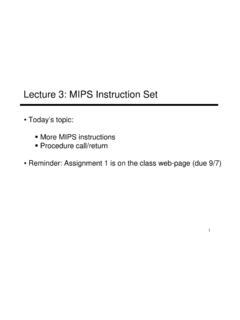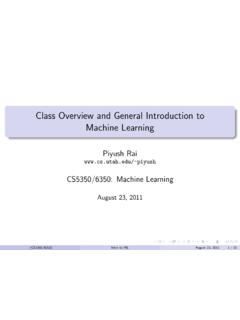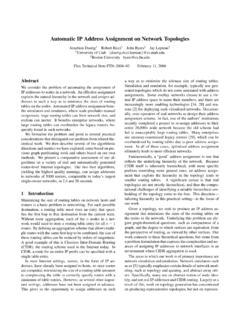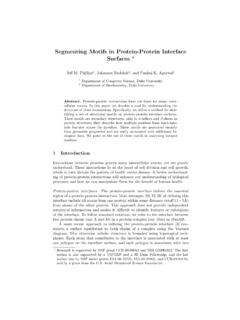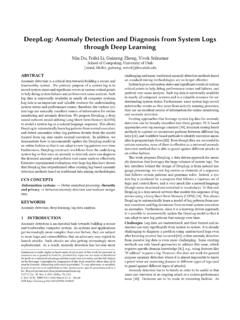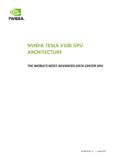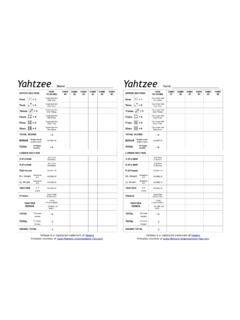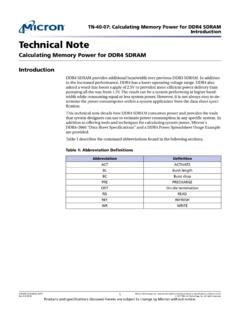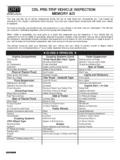Transcription of Highlights of the High- Bandwidth Memory (HBM) Standard
1 Highlights of the high - Bandwidth Memory (HBM) Standard Mike O Connor Sr. Research Scientist The Memory Forum June 14, 2014 What is high - Bandwidth Memory (HBM)? Memory Standard designed for needs of future GPU and HPC systems: Exploit very large number of signals available with die-stacking technologies for very high Memory Bandwidth Reduce I/O energy costs Enable higher fraction of peak Bandwidth to be exploited by sophisticated Memory controllers Enable ECC/Resilience Features JEDEC Standard JESD235, adopted Oct 2013. Initial work on Standard started in 2010 The Memory Forum June 14, 2014 What is high - Bandwidth Memory (HBM)?
2 Enables systems with extremely high Bandwidth requirements like future High- performance GPUs The Memory Forum June 14, 2014 HBM Overview Standard defines an HBM stack Bonding footprint Interface Signaling Commands & Protocol Some optional features: ECC support Base-layer logic/redistribution/IO die Standard does not define Internal architecture of the stack Precise DRAM timing parameters The Memory Forum June 14, 2014 HBM Overview Each HBM stack provides 8 independent Memory channels These are completely independent Memory interfaces Independent clocks & timing Independent commands Independent Memory arrays In short, nothing one channel does affects another channel 4 DRAM dies with 2 channels per die Optional Base Logic Die Channel 0 Channel 1 *Figure from JEDEC Standard high Bandwidth Memory (HBM)
3 DRAM, JESD 235, Oct. 2013 The Memory Forum June 14, 2014 HBM Overview - Bandwidth Each channel provides a 128-bit data interface Data rate of 1 to 2 Gbps per signal (500-1000 MHz DDR) 16-32 GB/sec of Bandwidth per channel 8 Channels per stack 128-256 GB/sec of Bandwidth per stack For comparison: Highest-end GPU today (NVIDIA GeForce GTX TITAN Black) 384b wide GDDR5 (12 x32 devices) @ 7 Gbps = 336 GB/s Future possible GPU with 4 stacks of HBM Four stacks of HBM @ 1-2 Gbps = 512 GB/s - 1 TB/s cost The Memory Forum June 14, 2014 HBM Overview - Bandwidth Each channel provides a 128-bit data interface Data rate of 1 to 2 Gbps per signal (500-1000 MHz DDR) 16-32 GB/sec of Bandwidth per channel 8 Channels per stack 128-256 GB/sec of Bandwidth per stack For comparison.
4 Highest-end GPU today (NVIDIA GeForce GTX TITAN Black) 384b wide GDDR5 (12 x32 devices) @ 7 Gbps = 336 GB/s cost Future possible GPU with 4 stacks of HBM Four stacks of HBM @ 1-2 Gbps = 512 GB/s - 1 TB/s power cost At lower overall DRAM system power. ~6-7 pJ/bit vs. ~18-22 pJ/bit for GDDR5 The Memory Forum June 14, 2014 HBM Overview - Capacity Per-channel capacities supported from 1-32 Gbit Stack capacity of 1 to 32 GBytes Near-term, at lower-end of range 4 high stack of 4Gb dies = 2 GBytes/stack 8 or 16 banks per channel 16 banks when > 4 Gbit per channel (> 4 GBytes/stack)
5 Not including optional additional ECC bits A stack providing ECC storage may have more bits The Memory Forum June 14, 2014 HBM Channel Overview Each channel is similar to a Standard DDR interface Data interface is bi-directional Still requires delay to turn the bus around between RD and WR Burst-length of 2 (32B per access) Requires traditional command sequences Activates required to open rows before read/write Precharges required before another activate Traditional dram timings still exist (tRC, tRRD, tRP, tFAW, etc.) but are entirely per-channel The Memory Forum June 14, 2014 HBM Channel Summary Function # of Bumps Notes Data 128 DDR, bi-directional Column Command/Addr.
6 8 DDR Row Command/Addr. 6 DDR Data Bus Inversion 16 1 for every 8 Data bits, bi-directional Data Mask/Check Bits 16 1 for every 8 Data bits, bi-directional Strobes 16 Differential RD & WR strobes for every 32 Data bits Clock 2 Differential Clock Clock Enable 1 Enable low-power mode Total 193 The Memory Forum June 14, 2014 New: Split Command Interfaces 2 semi-independent command interfaces per channel Column Commands Read / Write Row Commands ACT / PRE / etc. Key reasons to provide separate row command i/f: 100% col. cmd Bandwidth to saturate the data bus w/ BL=2 Simplifies Memory controller Better performance (issue ACT earlier or not delay RD/WR) Still need to enforce usual ACT RD/WR PRE timings The Memory Forum June 14, 2014 New.
7 Single-Bank Refresh Current DRAMs require refresh operations Refresh commands require all banks to be closed ~ 1 refresh command every few sec Can consume 5-10% of potential Bandwidth Increasing overheads with larger devices Sophisticated DRAM controllers work hard to overlap ACT/PRE in one bank with traffic to other banks Can manage the refresh similarly Added Refresh Single Bank command Like an ACT, but w/ internal per-bank row counter Can be issued to any banks in any order Memory controller responsible for ensuring all banks get enough refreshes each refresh period The Memory Forum June 14, 2014 New: Single-Bank Refresh Refresh (All Banks) ACT ACT ACT RD RD ACT ACT ACT RD RD PRE PRE PRE PRE REFSB PRE REFSB RD ACT PRE ACT RD PRE Traditional Precharge-All and Refresh-All Arbitrary Single-Bank Refresh Bank 0 Bank 1 Bank n Bank 0 Bank 1 Bank n PRE PRE The Memory Forum June 14, 2014 New: RAS Support HBM Standard supports ECC Optional.
8 Not all stacks required to support it ECC and non-ECC stacks use same interface Key insight: Per-byte data mask signals and ECC not simultaneously useful Data Mask Signals can carry ECC data - makes them bi-directional on HBM stacks that support ECC Parity check of all cmd/addr busses also supported The Memory Forum June 14, 2014 Other HBM Features HBM supports Temperature Compensated Self Refresh Temperature dependent refresh rates with several temperature ranges ( cool/standby, normal, extended, emergency) Temperature sensor can be read by Memory controller to adjust its refresh rates as well Data Bus Inversion coding to reduce number of simultaneously switching signals No more than 4 of 9 (DQ[ ], DBI) signals switch DBI computation maintained across consecutive commands The Memory Forum June 14, 2014 QUESTIONS?
9 Thank You The Memory Forum June 14, 2014 BACKUP The Memory Forum June 14, 2014 BACKUP Footprint The Memory Forum June 14, 2014 HBM Footprint *Figure from JEDEC Standard high Bandwidth Memory (HBM) DRAM, JESD 235, Oct. 2013 The Memory Forum June 14, 2014 HBM Footprint Half of One channel Data i/f Four channels Command i/f *Figure from JEDEC Standard high Bandwidth Memory (HBM) DRAM, JESD 235, Oct. 2013 The Memory Forum June 14, 2014 BACKUP Commands The Memory Forum June 14, 2014 Column Commands Command Clock C[0:7] Column NOP Rising CNOP / XXXXX Falling XXXXXXX / Parity Read Rising RD / Autoprecharge / Bank Falling Column Address / Parity Write Rising RD / Autoprecharge / Bank Falling Column Address / Parity Mode Register Set Rising MRS / Mode Reg Falling Opcode The Memory Forum June 14, 2014 Row Commands Command Clock R[0:5] Row NOP Rising RNOP / XXX Falling XXXXX / Parity Activate Rising ACT / Bank Falling Row Address[15:11] / Parity Rising Row Address[10.]
10 5] Falling Row Address[4:0] / Parity Precharge Rising PRE / Bank Falling XXXXX / Parity Precharge All Banks Rising PREA / XXX Falling XXXXX / Parity Refresh (single bank) Rising REFSB / Bank Falling XXXXX / Parity Refresh (all banks) Rising REF / XXX Falling XXXXX / Parity The Memory Forum June 14, 2014 BACKUP RAS The Memory Forum June 14, 2014 HBM RAS Challenges Stacked Memory has some challenges with respect to RAS requirements Traditional DRAM DIMMs get only a subset of bits ( 4) from each burst from a single DRAM device HBM gives you all the bits of a burst from a single row of a single bank of a single DRAM device Good for power, but RAS-wise all our eggs are in one basket Including the ECC bits Need techniques to detect failures ( row decode fault) Need techniques to recover from failures ( RAID-like schemes)
